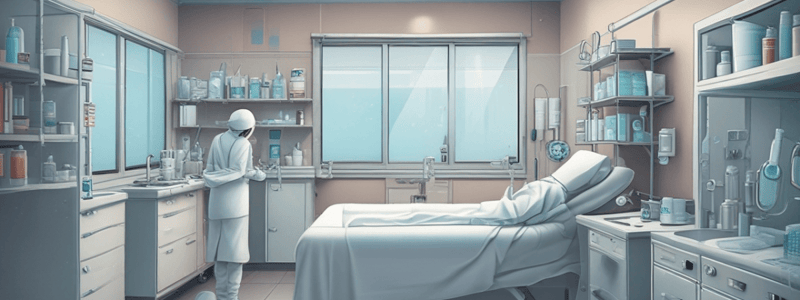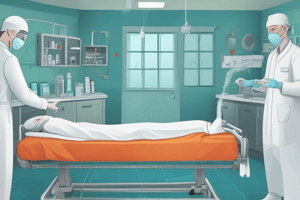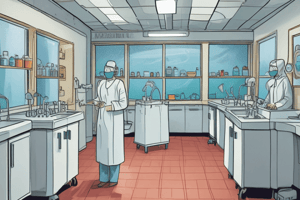Podcast
Questions and Answers
What is the primary purpose of aseptic hand washing?
What is the primary purpose of aseptic hand washing?
- To clean under the fingernails
- To moisturize the skin
- To reduce the transmission of infectious diseases (correct)
- To remove dirt and oils from the skin
What is the purpose of standard precautions in healthcare?
What is the purpose of standard precautions in healthcare?
- To protect healthcare workers from infection (correct)
- To isolate infected patients
- To dispose of bio-hazardous materials
- To sterilize medical instruments
What is an important factor that inhibits the growth of microorganisms?
What is an important factor that inhibits the growth of microorganisms?
- Warm temperatures
- Dry environments (correct)
- Moist environments
- Ultraviolet light
What is the proper technique for handling soiled linens?
What is the proper technique for handling soiled linens?
What is the purpose of sterilizing medical instruments?
What is the purpose of sterilizing medical instruments?
What is the primary goal of infection control techniques in healthcare?
What is the primary goal of infection control techniques in healthcare?
What is a critical step in the proper disposal of bio-hazardous materials?
What is a critical step in the proper disposal of bio-hazardous materials?
What is the main purpose of standard precautions in healthcare?
What is the main purpose of standard precautions in healthcare?
What is a factor that promotes the growth of microorganisms?
What is a factor that promotes the growth of microorganisms?
What is the primary way the body protects against microorganisms and infection?
What is the primary way the body protects against microorganisms and infection?
Which of the following is NOT a standard precaution used in healthcare?
Which of the following is NOT a standard precaution used in healthcare?
What is the primary purpose of sterilizing medical instruments?
What is the primary purpose of sterilizing medical instruments?
What is a factor that promotes the growth of microorganisms?
What is a factor that promotes the growth of microorganisms?
Which of the following is a way the body protects against microorganisms and infection?
Which of the following is a way the body protects against microorganisms and infection?
What is the primary purpose of OSHA and CEC standards for infection control?
What is the primary purpose of OSHA and CEC standards for infection control?
Flashcards are hidden until you start studying
Study Notes
Infection Control
Aseptic Hand Washing
- Wash hands with soap and water for at least 20 seconds
- Use warm water and mild soap
- Rub hands together to create friction
- Pay attention to areas between fingers, under nails, and wrists
- Rinse thoroughly with warm water
- Dry hands completely with a single-use towel
Infection Control Techniques
- Use personal protective equipment (PPE) such as gloves, masks, and gowns
- Implement standard precautions for all patients, not just those with known infections
- Practice proper sterilization and disinfection of equipment and surfaces
- Follow proper procedures for handling and disposing of bio-hazardous materials
- Use aseptic technique when handling invasive medical devices
OSHA and CEC Standards
- OSHA (Occupational Safety and Health Administration) regulates workplace safety and health
- CEC (Centers for Disease Control and Prevention) sets guidelines for infection control in healthcare
- Both organizations emphasize the importance of proper infection control practices
Disposing of Bio-Hazardous Materials
- Use designated containers and bags for disposing of bio-hazardous materials
- Follow proper procedures for handling and transporting these materials
- Ensure proper labeling and segregation of bio-hazardous materials
Handling Linens and Clothing
- Handle clean linens and clothing in a way that prevents contamination
- Use designated areas and containers for soiled linens and clothing
- Follow proper procedures for laundering and disinfecting linens and clothing
Standard Precautions
- Wear gloves, masks, gowns, caps, and protective eyewear as needed
- Use these precautions with all patients, not just those with known infections
- Implement these precautions to prevent transmission of infectious diseases
Cleaning and Sterilizing Instruments and Supplies
- Follow proper procedures for cleaning, disinfecting, and sterilizing instruments and supplies
- Use designated cleaning solutions and equipment
- Ensure proper storage and handling of cleaned and sterilized instruments and supplies
Microorganism Growth
- Factors that promote growth: moisture, warmth, nutrients, and pH
- Factors that inhibit growth: dryness, cold, lack of nutrients, and extreme pH
Body's Defense Against Microorganisms
- Skin and mucous membranes act as a barrier to prevent entry of microorganisms
- Immune system responds to presence of microorganisms
- Body's natural defenses can be compromised by certain medical conditions or treatments
Infection Control
Aseptic Hand Washing
- Wash hands with soap and water for at least 20 seconds
- Use warm water and mild soap
- Rub hands together to create friction
- Pay attention to areas between fingers, under nails, and wrists
- Rinse thoroughly with warm water
- Dry hands completely with a single-use towel
Infection Control Techniques
- Use personal protective equipment (PPE) such as gloves, masks, and gowns
- Implement standard precautions for all patients, not just those with known infections
- Practice proper sterilization and disinfection of equipment and surfaces
- Follow proper procedures for handling and disposing of bio-hazardous materials
- Use aseptic technique when handling invasive medical devices
OSHA and CEC Standards
- OSHA (Occupational Safety and Health Administration) regulates workplace safety and health
- CEC (Centers for Disease Control and Prevention) sets guidelines for infection control in healthcare
- Both organizations emphasize the importance of proper infection control practices
Disposing of Bio-Hazardous Materials
- Use designated containers and bags for disposing of bio-hazardous materials
- Follow proper procedures for handling and transporting these materials
- Ensure proper labeling and segregation of bio-hazardous materials
Handling Linens and Clothing
- Handle clean linens and clothing in a way that prevents contamination
- Use designated areas and containers for soiled linens and clothing
- Follow proper procedures for laundering and disinfecting linens and clothing
Standard Precautions
- Wear gloves, masks, gowns, caps, and protective eyewear as needed
- Use these precautions with all patients, not just those with known infections
- Implement these precautions to prevent transmission of infectious diseases
Cleaning and Sterilizing Instruments and Supplies
- Follow proper procedures for cleaning, disinfecting, and sterilizing instruments and supplies
- Use designated cleaning solutions and equipment
- Ensure proper storage and handling of cleaned and sterilized instruments and supplies
Microorganism Growth
- Factors that promote growth: moisture, warmth, nutrients, and pH
- Factors that inhibit growth: dryness, cold, lack of nutrients, and extreme pH
Body's Defense Against Microorganisms
- Skin and mucous membranes act as a barrier to prevent entry of microorganisms
- Immune system responds to presence of microorganisms
- Body's natural defenses can be compromised by certain medical conditions or treatments
Infection Control
Aseptic Hand Washing
- Wash hands with soap and water for at least 20 seconds
- Use warm water and mild soap
- Rub hands together to create friction
- Pay attention to areas between fingers, under nails, and wrists
- Rinse thoroughly with warm water
- Dry hands completely with a single-use towel
Infection Control Techniques
- Use personal protective equipment (PPE) such as gloves, masks, and gowns
- Implement standard precautions for all patients, not just those with known infections
- Practice proper sterilization and disinfection of equipment and surfaces
- Follow proper procedures for handling and disposing of bio-hazardous materials
- Use aseptic technique when handling invasive medical devices
OSHA and CEC Standards
- OSHA (Occupational Safety and Health Administration) regulates workplace safety and health
- CEC (Centers for Disease Control and Prevention) sets guidelines for infection control in healthcare
- Both organizations emphasize the importance of proper infection control practices
Disposing of Bio-Hazardous Materials
- Use designated containers and bags for disposing of bio-hazardous materials
- Follow proper procedures for handling and transporting these materials
- Ensure proper labeling and segregation of bio-hazardous materials
Handling Linens and Clothing
- Handle clean linens and clothing in a way that prevents contamination
- Use designated areas and containers for soiled linens and clothing
- Follow proper procedures for laundering and disinfecting linens and clothing
Standard Precautions
- Wear gloves, masks, gowns, caps, and protective eyewear as needed
- Use these precautions with all patients, not just those with known infections
- Implement these precautions to prevent transmission of infectious diseases
Cleaning and Sterilizing Instruments and Supplies
- Follow proper procedures for cleaning, disinfecting, and sterilizing instruments and supplies
- Use designated cleaning solutions and equipment
- Ensure proper storage and handling of cleaned and sterilized instruments and supplies
Microorganism Growth
- Factors that promote growth: moisture, warmth, nutrients, and pH
- Factors that inhibit growth: dryness, cold, lack of nutrients, and extreme pH
Body's Defense Against Microorganisms
- Skin and mucous membranes act as a barrier to prevent entry of microorganisms
- Immune system responds to presence of microorganisms
- Body's natural defenses can be compromised by certain medical conditions or treatments
Studying That Suits You
Use AI to generate personalized quizzes and flashcards to suit your learning preferences.




